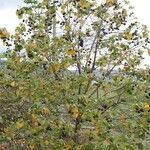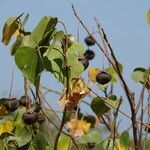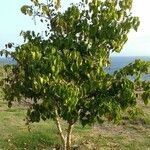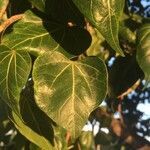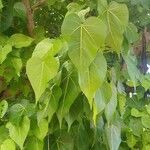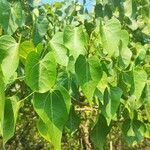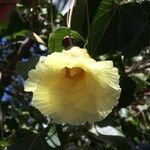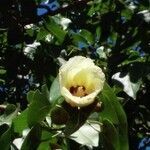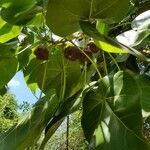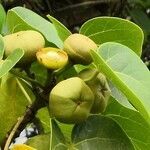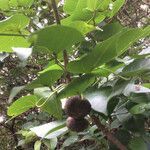Trees or shrubs, evergreen, 3-6 m tall. Branchlets with minute brown peltate scales, sometimes dense. Stipules filiform-lanceolate, 2-7 mm, usually caducous; petiole 4-10 cm, scaly; leaf blade ovate-cordate to triangular, 7-18 × 4.5-12 cm, abaxially with scales, adaxially glabrous or with scales, base truncate to cordate, margin entire, apex long caudate. Flowers solitary, axillary. Pedicel 2.5-6 cm, densely scaly. Epicalyx lobes 3-4, filiform-lanceolate, 8-10 mm, usually caducous, scaly. Calyx cup-shaped, 1-1.5 cm in diam., subtruncate with 5 ca. 0.5 mm teeth, densely scaly. Corolla yellow, adaxially purple at base, campanulate, ca. 5 cm. Staminal column ca. 25 mm. Fruit stipe 6-8 cm. Capsule globose to pyriform, ca. 5 × 2 cm in diam., slightly fleshy, ± indehiscent. Seeds triangular-ovoid, 8-9 mm, brown hairy or glabrous, veined. Fl. year-round.
An evergreen tree. It grows to 5-10 m high and spreads 2 m across. The stem is erect and branching. It has a compact crown. The outer bark is grey-brown. It is cracked along its length and scaly. The leaves are bluish green and broadly heart shaped. They are 5-15 cm long and 5-10 cm wide and taper to a tip. The leaves are thin and have very small scales on both surfaces. They are on long stalks. The leaves have nectar nearing zones at the bases of the midrib. The flowers are a sulphur-yellow. They have 5 petals and a purple throat. They occur singly. They are bell shaped. Flowers are 5-8 cm across. The flowers are somewhat like Hibiscus. The fruit is a round capsule 2.5 cm across. Sometimes it splits open into 5 valves revealing silky brown seeds. They are oval or triangle shaped and about 9 mm across.
Trees 2–12 m. Stems lepidote to glabrate when young. Leaves: stipules 3–7 mm; petiole mostly 2/3–1 times length of blade; blade 6–13 cm, apex acute or acuminate, venation palmate, with nectariferous zone near base of midrib. Inflorescences: flowers large. Pedicels erect, stout, shorter than subtending petiole; involucellar bractlets irregularly inserted, ligulate. Flowers: calyx 8–10 mm, subglabrous, minutely lepidote; petals 4–6 cm, punctate; staminal column pallid, ca. 1/2 length of petals, apically 5-dentate, glabrous; style exceeding stamens; stigmas decurrent. Capsules (3–)5-locular, 3–3.5 cm diam.. Seeds 8–9 mm. 2n = 24, 26.
Leaf-lamina up to 15 × 12 cm., entire, ovate to broadly ovate, densely lepidote on both surfaces, apex somewhat acuminate, base cordate 7-nerved; petiole up to 9 cm. long, lepidote; stipules 5–7 mm. long, lanceolate to almost subulate.
Epicalyx of 3 bracts; bracts 2–7 (11) mm. long, lanceolate-triangular to triangular, very early caducous.
Flowers up to 8 cm. in diam., yellow; peduncles up to 9 cm. long, not obviously articulated.
Petals 4 × 3·5 cm., obliquely obovate, lepidote outside, glabrous inside.
Staminal tube c. 17 mm. long; free parts of filaments 3–5 mm. long.
Seeds 10 × 6 mm., sericeous-tomentellous, somewhat glabrescent.
Fruit up to 25 × 30 mm., depressed-globose, lepidote.
Calyx c. 15 × 7 mm., densely lepidote, 5-dentate.
Small tree or shrub; branchlets densely lepidote.
